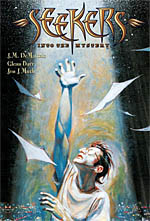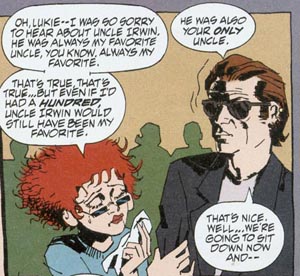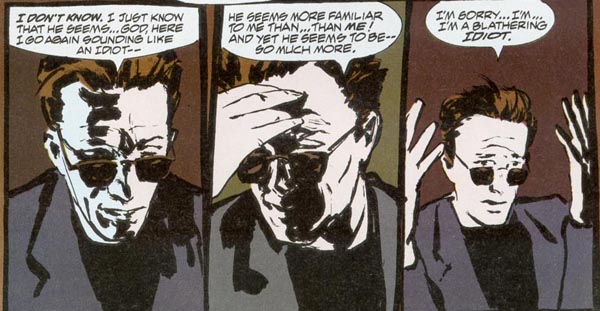 Written by J.M. DeMatteis
Written by J.M. DeMatteis
Art by Glenn Barr and Jon J Muth
128 pages, color
Published by Boom! Studios
Who says you can’t go home again? I remember when Seekers Into the Mystery first debuted at the end of 1995. I was reading J.M. DeMatteis’s and Glenn Barr’s collaboration Brooklyn Dreams and being absolutely dazzled by how well they worked together on DeMatteis’s semi-autobiographical story. I was pleased, then, to see that they were collaborating again—but at the time couldn’t shake the feeling that it was the same book but with cast later in life. Re-reading the book now, I can’t help but think that I have a greater appreciation for it now that it’s had some time away from Brooklyn Dreams and can better establish itself as its own work.
Lucas Hart dreamt he could fly as a child, and as soon as he was old enough he went out west to Hollywood to try and become a screenwriter. Now, years later, he’s washed up and pitching scripts to the worst shows on television. He has an ex-wife and daughter who tolerate him, and a girlfriend Rhonda who’s perhaps more than he deserves. But just when his life truly hits a low point, he has a vision of a man known as the Magician, and the pilgrimage of Lucas Hart finally begins.
 Seekers Into the Mystery was a series about a man trying to find himself, both mentally and spiritually. In some ways, I can’t help but think that’s why it only ran for 15 issues, because it was bound to scare away readers by its very content. Reading it over a decade later, it’s easy to see the spots that could be easily mocked or used as an excuse to give up on the book. DeMatteis seems to try and mitigate those points as best he can; that make sound a little strange at first, because he wrote the entire series. But they’re moments in the series that clearly meant a lot to him, and so while they’re included, there’s an additional wink to the audience that yes it’s a little odd in spots, due to the presence of an older, reflective Lucas Hart serving as a narrator remembering these events from his past. It mostly works, I think, because of this. Older Lucas Hart is in on the joke with us; he’s got the distance from the events to be able to nod ruefully in just the right spots, but at the same time he’s still bringing us to these points in his life because (silly or not) they’re key elements in how he finds himself.
Seekers Into the Mystery was a series about a man trying to find himself, both mentally and spiritually. In some ways, I can’t help but think that’s why it only ran for 15 issues, because it was bound to scare away readers by its very content. Reading it over a decade later, it’s easy to see the spots that could be easily mocked or used as an excuse to give up on the book. DeMatteis seems to try and mitigate those points as best he can; that make sound a little strange at first, because he wrote the entire series. But they’re moments in the series that clearly meant a lot to him, and so while they’re included, there’s an additional wink to the audience that yes it’s a little odd in spots, due to the presence of an older, reflective Lucas Hart serving as a narrator remembering these events from his past. It mostly works, I think, because of this. Older Lucas Hart is in on the joke with us; he’s got the distance from the events to be able to nod ruefully in just the right spots, but at the same time he’s still bringing us to these points in his life because (silly or not) they’re key elements in how he finds himself.
The spiritual aspect of Seekers Into the Mystery feels like an amalgamation of many different faiths and beliefs, rather than a single religion, group, or spiritual path that DeMatteis based it upon. In spots it’s a little distracting, because it’s hard to not keep picking at the tangle of ideas and trying to see where each individual strand is originally from. What’s interesting, though, is that at least in the first volume you can take Seekers Into the Mystery as so many different possible ways without any of them being invalidated. Is it something religious? Alien? Hallucinatory? A combination of some or all? It’s actually a little hard to say, especially with some of the more traumatic moments in the book. Those moments themselves can be a little hard to handle, but not only because of what happened but how the aftermath plays out. Even now, re-reading the final fate of Lucas’s father, it can be a tough moment to take. I have to give DeMatteis credit for taking the route that he does with the story, because it certainly isn’t an easy answer given to the reader or to Lucas Hart.
Glenn Barr’s art in the first four issues is as beautiful as I remembered it. It’s a rough, squiggled style that reminds me in many ways of those early sketches that artists create to help map out facial features and shapes of people’s bodies. Except, in the case of Barr’s art, he’s done so in a way that feels more finished and complete; all of the texture and contours of the characters are there, but it’s polished without losing those original raw sketches and shapes that one would create when feeling through the initial moments. The last chapter is drawn by another former collaborator of DeMatteis, in this case Jon J Muth. (Muth would also draw the final chapters of what will hopefully be the other two volumes of Seekers Into the Mystery.) The shift over to Muth is surprisingly seamless; while the two have very different finished styles, Muth clearly takes a cue from Barr and alters the looks of his characters accordingly, while still saying true to his own, heavily inked method of art. Muth’s probably at his best drawing portraits of times past in his chapter, but even his panel-to-panel work is attractive to look at. It’s a rare non-painted contribution from Muth, and it’s a nice reminder that he’s quite good at other styles of art, too.

Thanks to it being so long since it was first published, it’s much harder to remember the exact comparisons between Brooklyn Dreams and Seekers Into the Mystery, and I think that’s a good thing. While they’re both books about finding one’s self, Seekers Into the Mystery certainly heads into a different direction, and it’s nice that it can do so in the 21st century without most of its readers forever glancing into a different direction. Hopefully we’ll see the remaining two volumes of Seekers Into the Mystery before too long; not only so the beautiful art from Michael Zulli, Jill Thompson, and Jon J Muth will get reprinted, but so all the other readers who head on Lucas Hart’s journey get to see its conclusion. I remember being attracted to DeMatteis’s honest and open nature of his scripts for Seekers Into the Mystery back in the day, and it’s nice to go on that journey one more time.
Purchase Links: Amazon.com | Powell’s Books
